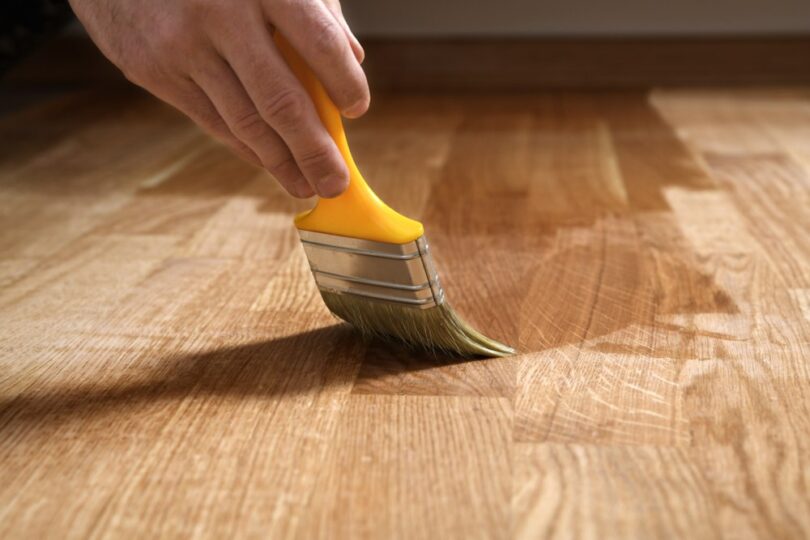Your old furniture needs some renovation and you have to peel off the varnish. But you don’t want to use those chemical removers in your house. What to do now?
Well, you’ve come to the right place. Here we’ve covered everything there is on how to remove varnish from wood with vinegar. Keep reading till the end.
Can you use vinegar on wood?
Many people ask this question since they know vinegar is an acidic solution and fear that it can damage their wood permanently.
However, the answer is yes, you can use vinegar without causing any harm to your wooden properties. White vinegar is used for both cleaning and polishing the wood. For cleaning, all you have to do is mix it with water while for polishing, you have to mix oil.
But don’t use undiluted vinegar because it can leave water marks on the wood and spoil the finish.
Does vinegar remove varnish from wood?
Varnish is the final coat applied on a wood finish to protect the stain and give it a glossy look. Sometimes, you may have to remove the varnish for either re-staining or repair.
Vinegar is an excellent solvent. In fact, it has been tested as a useful component to polish woods and remove varnishes.
So, how does vinegar remove varnish from wood?
This is due to the acidic nature of vinegar. Acetic acid is usually a weak acid. But it’s good enough to soften the top-coat of the wood, make it less adhesive and even break it down or dissolve it so you can remove it easily.
Why Use Vinegar?
You can always go to the market and buy commercial varnish removers. They work perfectly well but the problem is they are strong chemicals with some toxic compounds.
These toxins will surely damage your favorite furniture.
On top of that, some of these toxins can be dangerous for your own health. Some people have reported allergic reactions to the chemicals. Others have said to have breathing problems from inhaling the gas. Also, if you directly touch it, they can cause severe skin conditions as well.
In order to keep both you and your furniture safe, we recommend that you use an organic option like vinegar.
Vinegar is a natural solvent. If you use a homemade remover with vinegar, it will work just as effectively as any other chemical. But it’s non-toxic and environment-friendly unlike them. Also, vinegar gives off a mild odor which makes it easy for you to concentrate. It works gently on the wood and leaves no damage at all – not to mention how readily available and cost-effective it is.
How to remove varnish from wood with vinegar? : Step-by-Step
1. Get your tools and ingredients
You’ll have to prepare the homemade remover first. For that, you’ll need:
- White vinegar
- Cornstarch
- Water
- Baking soda
- Ammonia
- Container
- Bucket
- Microwave
- Rubber gloves
- Tablespoon
- Cups
When the solution is ready, it’s time to do the main thing. You’ll require-
- Paintbrush
- Toothbrush
- Rubbing alcohol
- Microfiber Towel
- Rag
- Water
2. Prepare the vinegar
Keep your white vinegar in a separate container.
First, boil 4 cups of water in a pot over a stove or any other heating device. You should try to use distilled water instead of tap water since the minerals from the tap water can contaminate the solution. After boiling, take the pot off the oven and let it cool down for a few minutes.
Mix a cup of cornstarch in a ½ cup of cold water and stir properly.
Take the boiled water in a large container or a bucket and add 1 tablespoon of white vinegar, ¾ cup of ammonia and ½ cup of ammonia. Stir and mix well with preferably a wooden spoon.
While mixing, you need to pour the cold water mixture of cornstarch into the bucket and stir more to prepare this homemade varnish remover with vinegar.
3. Apply the remover
Use the rubber glove to protect your skin from any undesired contact with the mixture.
Then, clean and trim your paintbrush. If the paintbrush isn’t looking good, get a new one from the market.
Dip the brush into the mixture while it’s still hot and start spreading it over the wood surface. If it’s a little late and the mixture has already cooled down, you should reheat it in the microwave and use again. Don’t forget to apply the solution all over the varnish. Let it sit for a while before you take the next step.
4. Scrub the varnish
Take a clean rag and soak it well in hot water. Then squeeze out the excess water and use it to scrub the surface. Use an old toothbrush to scrub the hard-to-reach areas on the wood.
You may have to repeat steps 2 and 3 until the whole thing is gone.
5. Rub alcohol
After you’ve removed the varnish, soak a microfiber towel in alcohol and rub it over the surface. This will help ensure that any residue from the varnish is scrubbed off. Alcohol also helps wipe out any dirt from the pores of the wooden furniture.
6. Wash and dry
Finally, rinse the whole wood in lukewarm water and dry it off with a microfiber towel to take out any excess moisture.
If you still feel that the wood has any more varnish left and the surface is sticky, you can repeat the whole procedure.
Final Words
Now that you know how to remove varnish from wood with vinegar, could it be any easier than this? Just take some vinegar from your kitchen and follow the instructions carefully.
This tutorial will surely help you if you want to renovate or repaint your wooden stuff at home without using any of those toxic chemical removers in the market.
The materials are well within your reach. All you have to do is get to work! Good luck!
FAQs
Q. Why is my varnished wood sticky?
Ans. Dirt is probably the reason. If the varnish captures dirt, the surface of the wood comes out sticky.
Q. What kind of vinegar should I use on wood?
Ans. White vinegar. It’s a non-toxic form of a weak acetic acid which is used extensively for cleaning purposes.
Q. Can I use a paper towel to remove the sticky surface on my wood?
Ans. No, it’s not recommended for you to use a paper towel to smooth sticky surfaces. Paper towels are usually used to dry a surface after addition or removal of oils and other substances.








